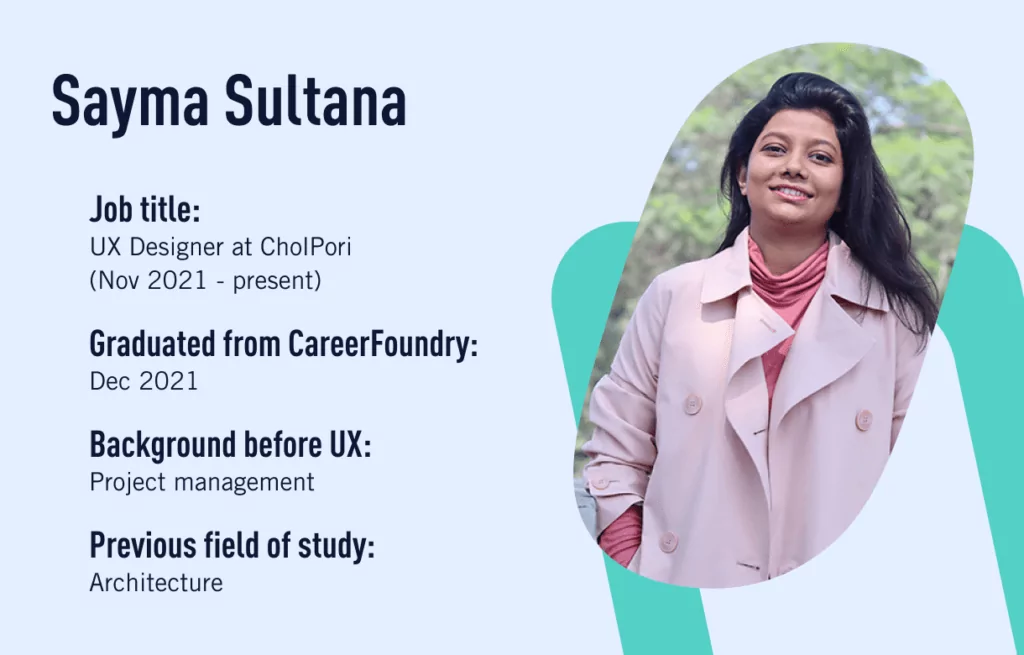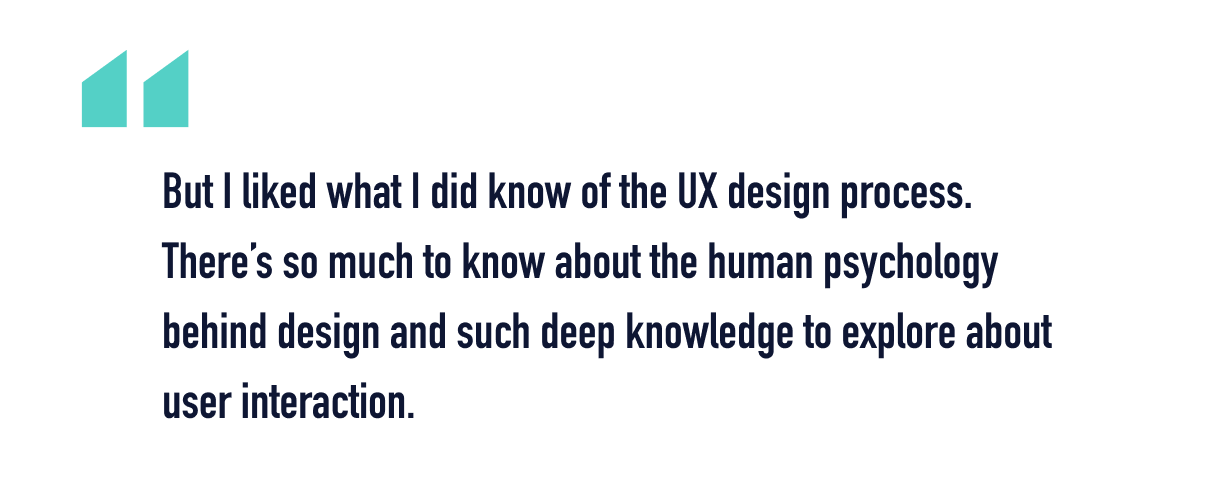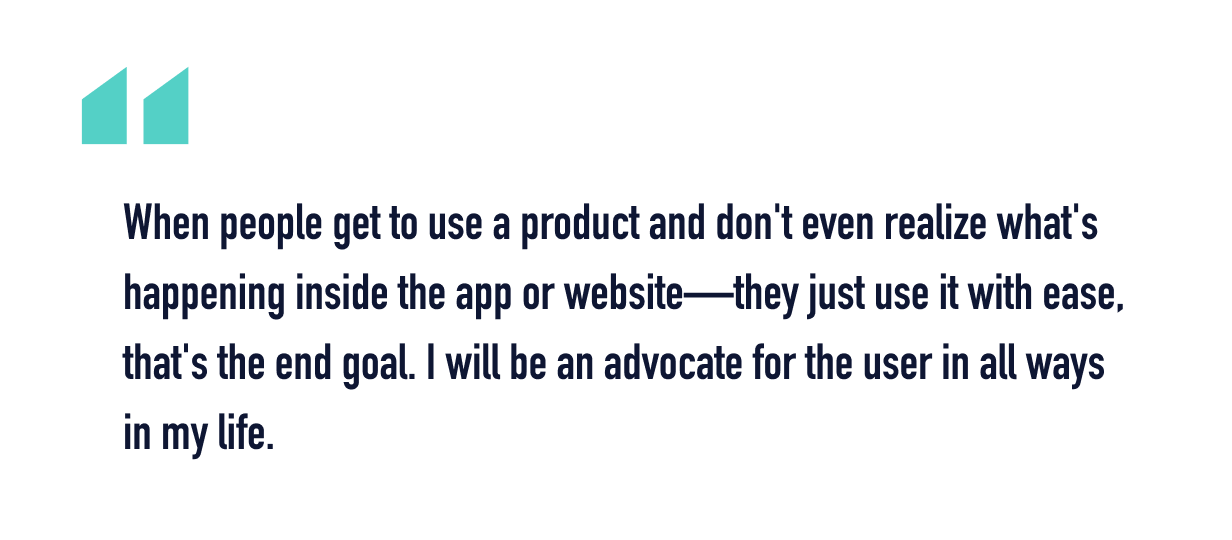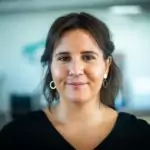
Sayma and I meet in an online call—it’s late afternoon for her in Dhaka and lunchtime for me in Berlin. I’m curious to know what her day has been like and what life is like in general for a UX designer in Bangladesh. Luckily for me, Sayma is keen to share her story from architecture to UX design.
As well as learning all about her work as a UX designer at CholPori—an e-learning tool for children in Bangladesh, Sayma and I chat about human behavior and how our brains work, the value of LinkedIn, and how CareerFoundry’s UX Design Program was like learning a gourmet recipe.
If you’re looking for inspiration about alternate jobs for architects, read on to learn more about transitioning to UX design!
Hello Sayma! Could you tell me a little bit about yourself and your background before CareerFoundry?
I studied architecture and did one or two jobs in that field. But at that same time, I thought that technology was booming and I was fascinated with it, so I started searching for something more exciting.
I got a copywriting job in a digital marketing agency, working with several renowned brands. I liked the dynamic of that. Then, I got a project management trainee role with the same agency. They were experimenting with me really, as I was very interested and curious about everything.
After that trainee role, I pitched a website design to a client, and they offered me a junior UX designer role. Well, they called it UX design, but mostly it was designing websites for clients, and I wasn’t the junior designer—I was the only designer! So I wasn’t learning as much as I expected, and it wasn’t really the role I had in mind.
Did you still consider UX design a good alternate job for architects at this point?
Yes, although it was very nerve-racking for me in that role, I still thought my architecture background was a good fit for UX because I have a strong sense of design principles.

It was at some point during this time that I quit my job and started my own company. I designed one or two websites for some clients and doing that made me very enthusiastic to learn more about UX design. I also saw that there were so many opportunities for UX designers when I was working on my own company.
What led you to think you needed to understand the theory and principles of UX?
I wanted to know more about human behavior and the users. Mostly, I was interested in human psychology because I didn’t understand my own self that much. I don’t have many similarities with other people around me. I struggled with different things that other people struggle with, so I was always very curious about my own behavior!
I see. And what led you to find CareerFoundry?
The CareerFoundry website was very informative, and the learning process suited me very much. I was perhaps a bit cynical about the full UX Design Program because it has a job guarantee and mentor and tutor support—I thought it was too good to be true.
So I took the Intro to UX Design Course first to see how that works. If I liked it, I would then take the immersion course. And I loved it! I got all the things I was promised—it was all true!
What was your favorite thing about studying with CareerFoundry?
Everything. I loved my tutor! I loved our interactions. Even now, I still talk with him! We brainstorm ideas, I ask him questions, and he shares resources with me. He’s so resourceful and knowledgeable, and I find it so insightful. I’ve learned a lot from him. Other than that, I love the CareerFoundry network of students, and the CareerFoundry network on LinkedIn.
Were there any challenges you faced while studying?
I had some discoveries about myself while studying. When I was studying architecture, I didn’t have difficulties with designing or presenting my work, but I struggled with attention and understanding what actually goes on in my mind.
With CareerFoundry, I was working on a self-paced course, I had regular access to my tutor, and I could submit work in my own time, but still I struggled with submitting tasks regularly. I skipped two weeks’ work at times, and then after two weeks I would come back and keep going.
So the struggle was actually within me. I figured that I had some deeper difficulties, and I am looking into the possibility now that I have a deficiency in attention or something similar.
CareerFoundry is very inclusive though; they were really helpful about this. However much I messed up with deadlines, it didn’t matter because they helped me with everything. They gave me a free extension, and I bought one extension myself, and then I finished the course!
My tutor was very helpful throughout the process, too. He didn’t push me, but he encouraged me, for example, to submit the work even if it wasn’t ready, and he reassured me we would discuss it together.
That’s good. I’ve heard other graduates say the same—that their mentor or tutor encouraged them to submit work even if it wasn’t quite finished, to discuss it together and go over any problems.
Yes. I was also doing another project with my mentor. That’s another reason why I was very slow-paced in the immersion course. I was working with my mentor on a different project to put into my portfolio, and that helped me to get a job.
That’s a nice segue. What was the job searching experience like?
I started looking for jobs when I was about to finish the course, and while I was doing the Job Preparation Course. I wanted to get a remote job or relocate to Berlin, but I kept getting rejected. I would get messages from recruiters from Berlin with potential job leads, but after they learned about my location, they would say they needed someone in Berlin or that they couldn’t help me relocate. I was feeling very nervous about it, but I learned a lot from the experience.
In Dhaka, I actually wasn’t that interested in staying and working here. But after my current employer, CholPori, got in touch with me and I got the interview, my perspective changed.
Did CholPori find and approach you?
Yes. Our founder messaged me on LinkedIn. So as I said before, LinkedIn has been very helpful for me!
Recommended viewing: How to Network in Tech
What was the recruitment process like?
I had two interviews, and they gave me a design challenge. But before all that, I had to fill out answers to some interesting questions on a document. I like to do that because it’s another way to show recruiters about yourself, and it’s a good way to prove you have the scope to let them know about yourself on paper.
They loved the design challenge. After I joined the company, the first main thing I did was to fix their website according to my design challenge!
So you were actually able to use the work you had done in the task!
Yes exactly! I actually did two tasks for them. The first was for a project lead designer, and because I was new to the field, they said maybe the post wasn’t for me. Instead, they asked me to take home another challenge for a customer experience role.
I was very confused, though. I talked to my career specialist at CareerFoundry, and she encouraged me to be positive about the situation and not reject the opportunity right away.

Amazing! Could you tell us a little bit about the company and what your role is like?
CholPori is a very interesting workplace. It’s an app and learning tool full of educational resources for kids in Bangladesh. We don’t have many interactive resources for children here in our native language, so we are making it! We’re working on illustrations, visuals, and animations of textbook lessons in an interactive app.
I joined as a junior UX designer. The lead designer also joined at the same time as me, so my job was to assist him. But now I am a UX designer! I got promoted after four months.
For my first month or so, we were auditing previous designs, researching what can be improved, and then proposing the improved designs. I collaborated with the designer for all of this, and then after getting some feedback, we started working on the new wireframes and designs.
And was it all this hard work during this process that you think led to your promotion?
Actually, they wanted me to join as a junior UX designer with a four-month probation. So the promotion was quite normal—after probation I knew if I would be staying at CholPori, I would get the promotion.
It sounds like it’s going very well for you. And it sounds like a very valuable and rewarding app to work on, I think. Do you feel CareerFoundry has helped you in your role?
Of course it has helped! I unlearned things I had already learned myself before doing the course. And everything I apply now in my work is all from CareerFoundry. We are doing project-based work, brainstorming, researching, making wireframes, prototyping, iterating, and usability testing.
Everything I do in this position I learned from CareerFoundry; either from my tutor, mentor, the course, or from the resources shared with me from my instructors. I like to read a lot and my tutor gave me some good resources. I talked about this on LinkedIn several times about the resources and how they helped me a lot.
That’s good! I love your LinkedIn posts. You did a really nice post about 10 ways bootcamps can help you. You mentioned the CareerFoundry program was like a gourmet recipe—you might know the basics of cooking, but the gourmet recipe will help you elevate your skills.
Yes! It’s true. And if you are not a very gourmet kind of person, CareerFoundry will teach you to make a delicious dish, at the very least.
What is your favorite thing about working in UX?
That I’m making people’s lives easier. I say this literally because when I use a complicated website and I don’t get access to what I want, I just get frustrated.
When I studied human behavior and how people learn, how they react, and how they interact with tech, I knew I just wanted to make simple solutions to complex problems. That’s very rewarding.

Do you have any hopes for the future of your career?
I would love to continue to work on tech platforms for kids and maybe language learning products for children. Then I would love to explore ideas about improvement in learning for kids. That’s my dream actually.
You’re in a really good place now then, with CholPori. You mentioned that you were originally looking to work in Berlin and relocate, but how are you finding working in Dhaka?
It’s good. We do hybrid work, so we go to the office on sprint days and when we have to present our work and have meetings. But mostly we work from home; it’s pretty flexible.
In the future, maybe I’d still like to relocate to Berlin because I have big dreams to travel. I’d like to start learning German, but meanwhile, I like what I am doing, and I love this job. So I will keep learning and exploring the scope here in Dhaka and remote opportunities.
Good plan. The future of remote work is hopefully that you can be anywhere in the world and be able to contribute to a project.
Yes. Actually, I was thinking about someday becoming a tutor at CareerFoundry, because I’d like to interact with students. I always talk with present students who contact me now and want to learn more about my experience on the course or in the workplace after graduating. So I think maybe there’s a possibility for me to become a CareerFoundry tutor in the future too.
I think so too! If you could give some advice to anyone who is thinking of changing careers, what would you say to them?
I would like to say that if you have confidence and you believe in yourself, everything is going to work out eventually. Be unapologetically positive about yourself. Don’t doubt yourself; don’t let that even be an option. It might take four years or five years to change your career, but it doesn’t matter—you’ll get there someday. Keep working on yourself!
When you achieve something, you’ll have confidence and feel a sense of accomplishment, but when you fail, you need to know that you will learn something, and you might not fail at it again.
Remember, it is OK if you fail—you might fail in life in lots of different ways. But what’s your perspective? How do you see the situation you’re in? How do you feel about the triumphs and the problems, and how do you react to them? Because that’s very important. Being very positive about yourself takes a lot of practice.
Thanks, Sayma. How do you feel your life has changed since you studied with CareerFoundry?
My life has changed a lot because I am now doing a very rewarding job, which I wasn’t doing previously because of the gaps in my knowledge. Those gaps have now been filled with very rich resources, teaching, and learning.
Now, I feel so much more confident! I know what I want for myself, I know what motivates me, and how my brain works. I feel confident every day. I’m very grateful to CareerFoundry for that.
That’s great to hear, Sayma. It’s been great to hear your story and I wish you so much success at CholPori and your future career as a UX designer.
If you’ve made it this far and have been inspired by Sayma’s story, why not try this free, introductory short course to see if a career in UX design is a good fit for you too.
If you’d like to know more about how you can get a rewarding career in tech, book a free call with one of our expert program advisors.
Hopefully by now you realize that UX design roles are ideal alternate jobs for architects, and Sayma isn’t the only one to make the transition. Check out these success stories from other CareerFoundry graduates who made the switch from architecture to UX design:
- Career Change From Architecture: How David Made the Switch From Construction to UX Design
- Changing Career Paths: Ally’s Journey From Landscape Architecture to Product Design
